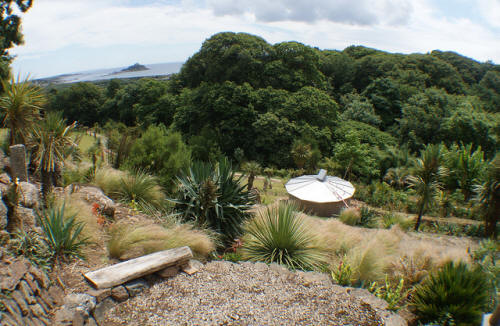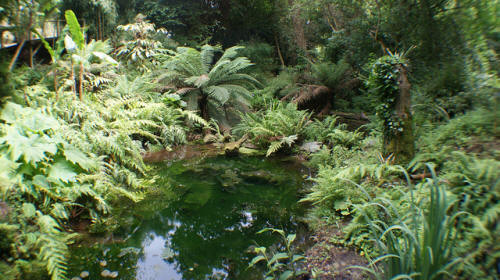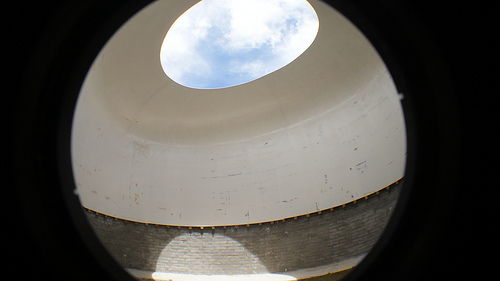|
Tremenheere thankyou
notes
Jan Coles on the sculpture
garden and site of James Turrell's only UK skyspace.
One of the joys of long-standing friendship is that you can say to
one another of painting or author or place, “This is precious to me,
take a look” and be reassured that your passion will be treated with
kindness and even joy. This is how it was in early August
when Caroline and David Windsor took me on a mystery tour to Lanyon
Farm, out past Madron Carn, and I at last introduced them to Tremenheere
Sculpture Gardens near Gulval.
 So singularly mysterious and beautiful is this garden to me that if
someone was to insist that I had dreamt it up I would half believe them.
Luckily however it does exist and I owe its place in my heart to another
friend of mine, Monica Wynter, who first took me to its May-time
Bluebell Festival three years ago now. The proceeds from this art
installation, plant sale and delicious food stalls went to the Medical
Foundation for the Care of Victims of Torture (which is the only
organisation in the UK to be solely dedicated to the treatment of
torture survivors). So singularly mysterious and beautiful is this garden to me that if
someone was to insist that I had dreamt it up I would half believe them.
Luckily however it does exist and I owe its place in my heart to another
friend of mine, Monica Wynter, who first took me to its May-time
Bluebell Festival three years ago now. The proceeds from this art
installation, plant sale and delicious food stalls went to the Medical
Foundation for the Care of Victims of Torture (which is the only
organisation in the UK to be solely dedicated to the treatment of
torture survivors).
The garden spills down the south-west facing hillside, a rich tapestry
of greens and gold upon the fertile soil. As a description this
immediately fails and frustrates me for of course it is the very
structural and architectural nature of the planting and design here
which so thrill the visitor. Tremenheere is the creation of doctors Neil
Armstrong and Jane Martin who have allowed the natural valley landscape
(along with their choice of rhododendrons, evergreen magnolias, palm
trees, giant ferns and exquisite bamboo and soft waist-high grasses) to
co-exist with man-made works of sculpture in restful harmony.
The late Irish theologian, long-time priest and poet/author John
O’Donohue would have loved this place. At the very edge of the land and
in perpetual relationship with the horizon it feels to me like one of
the ‘thin’ places of Celtic understanding. The veil between our physical
world and the numinous slips at these places so that when you arrive
here from crowdedness and noise it is indeed a ‘divine embrace’ that
settles about you. In his book ‘Divine Beauty-The Invisible Embrace’ he
writes:
“The beauty of the earth is the first beauty. Millions of years
before us the earth lived in wild elegance. Landscape is the first-born
of creation. Sculpted with huge patience over millennia, landscape has
enormous diversity of shape, presence and memory. There is poignancy in
beholding beauty…often it feels as though it has been waiting for
centuries for the recognition and witness of the human eye.”
It is John O’Donohue who suggests that when you love a place and honour
it with your attentive presence it will be loving you back with equal
tenderness. It will miss you when you are not there. It will wait for
your return and you will feel its rejoicing when together once more you
breathe of the same air.
 Whenever I go to Tremenheere I feel a great kindness here. Time slips.
Perhaps it is the love being poured into this place that greets me at
the old stone bridge across the stream. I am certain that the ‘wild
elegance’ achieved here through the gradually unfolding areas of the
garden make it a meditative and contemplative place. It is a Slow Garden
, drenched in birdsong, fragrant with trees. Whenever I go to Tremenheere I feel a great kindness here. Time slips.
Perhaps it is the love being poured into this place that greets me at
the old stone bridge across the stream. I am certain that the ‘wild
elegance’ achieved here through the gradually unfolding areas of the
garden make it a meditative and contemplative place. It is a Slow Garden
, drenched in birdsong, fragrant with trees.
Everyone who comes will see it differently but I experience it as a
series of circular ‘rooms’ or stories effortlessly drawing me up the
hillside between the wooded columns of its boundaries.
So I see the speckled woodland room with airy space between the trees,
the desert room with spiky sci-fi agaves, the American plains room with
sensuous waving grasses, the jungle room with exquisitely painted
bamboo. The primordial swamp room is almost black with giant ferns and
mossy pools, the dense and boggy woodland walk is made infinitely
pleasing by the boardwalk under foot. And at the very centre of the
garden, like the Grand Hall of a medieval castle, is the sunlit garden
room where the August heat, shimmering gold, bounced up from the springy
grass and winding path beyond the cool and sighing trees.
Numerous dragonflies zip-locked the air about us darting between dust
motes, which like the meteor showers above our heads this same week in
August, I imagined to be golden debris in their sights. A paper-thin
leaf blowing gently uphill as we approached our first resting place in
the woods turned out to be a tiny, inch-long frog! Right at Caroline’s
feet an origami frog! So delicate, so bony, wending its way up the
sunlit slope with movements as slow and precise as a mechanical toy.
And with the dream-like embrace of Tremenheere about me like a cloak I
implore first-time visitors to NOT LOOK BACK as you wander up the
hillside, do not be impatient as Orpheus was for a glance of his beloved
Eurydice. Allow the paths to lead you upwards to the curved seat of the
wooden viewing platform and keep your eyes focused on the gradually
emerging Mesa-like terrain and American artist James Turrell’s Skyspace.
 Only then may you stop and look back to find yourself amazed. And your
exclamation of, “Oh! Just look at that!” will join with the myriad of
voices preceding yours, now forever recorded in the air, on dragonfly
wingbeats, in the silvery grain of the wooden tower, itself a work of
art, built here to welcome you and bid you pause a while. At your feet a
stone built camera obscura and all about you, as if you have become a
bird, is the exhilarating light as your new element. And up here, close
to the clouds and the skyscapes, there appears to be, emerging from the
earth itself, a new temple which reminds you of more ancient
archaeological discoveries and creates an immediate curiosity and sense
of wonder. Only then may you stop and look back to find yourself amazed. And your
exclamation of, “Oh! Just look at that!” will join with the myriad of
voices preceding yours, now forever recorded in the air, on dragonfly
wingbeats, in the silvery grain of the wooden tower, itself a work of
art, built here to welcome you and bid you pause a while. At your feet a
stone built camera obscura and all about you, as if you have become a
bird, is the exhilarating light as your new element. And up here, close
to the clouds and the skyscapes, there appears to be, emerging from the
earth itself, a new temple which reminds you of more ancient
archaeological discoveries and creates an immediate curiosity and sense
of wonder.
What is this building? What is it going to show us surrounded, as it is
here, by granite boulders soaking up the sun and stony terraces of
palms, grasses and exotic desert plants?
We are rescued at this point by Andrew, the young weekend gardener, with
his knowledge of rare plants and their botanical naming and his
infectious enthusiasm for this whole project. Without now giving too
much away about the work in progress of James Turrell’s installation I
found myself at one of those ‘thin’ places in the garden. I thought of
cathedrals and the ‘temporary temples’ of August’s crop circles, of
sacred space and the way the light and wind and rain actively sculpt our
world. Up at this height it is easy to meditate on the ways that light
plays upon water, paints and shadows our waking moments and the way it
so pleases the human eye to look heavenwards.
We left the garden through the mossy woodland walk and I was taken off
to Lanyon Farm. Still stunned by Tremenheere it was lovely to sit in the
cool breeze of the tea garden and to look across the patchwork land
towards Carn Galver. Auburn and black feathered chickens paraded along
the stone hedge with Ding Dong mine in the background. The boxy fields
glowed emerald green as we sat and talked of Roger Deakin and his love
of wild swimming which thankfully survives him in his book ‘Waterlog.’
It was a perfect end to our day.
This year garden opening times have been extended to every weekend and
Bank Holiday until the end of October and a slide show (with
identification of some of its rare exotic and tender plants) can be seen
on the website
www.tremenheere.co.uk
|



 Only then may you stop and look back to find yourself amazed. And your
exclamation of, “Oh! Just look at that!” will join with the myriad of
voices preceding yours, now forever recorded in the air, on dragonfly
wingbeats, in the silvery grain of the wooden tower, itself a work of
art, built here to welcome you and bid you pause a while. At your feet a
stone built camera obscura and all about you, as if you have become a
bird, is the exhilarating light as your new element. And up here, close
to the clouds and the skyscapes, there appears to be, emerging from the
earth itself, a new temple which reminds you of more ancient
archaeological discoveries and creates an immediate curiosity and sense
of wonder.
Only then may you stop and look back to find yourself amazed. And your
exclamation of, “Oh! Just look at that!” will join with the myriad of
voices preceding yours, now forever recorded in the air, on dragonfly
wingbeats, in the silvery grain of the wooden tower, itself a work of
art, built here to welcome you and bid you pause a while. At your feet a
stone built camera obscura and all about you, as if you have become a
bird, is the exhilarating light as your new element. And up here, close
to the clouds and the skyscapes, there appears to be, emerging from the
earth itself, a new temple which reminds you of more ancient
archaeological discoveries and creates an immediate curiosity and sense
of wonder.